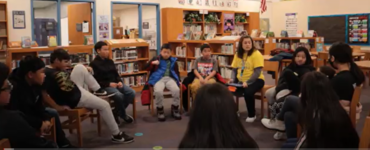Teachers will learn how to bring student languages into the ESL and general education classrooms by using Bridging – a strategy that enhances metalinguistic skills and places students as the knowledge holders in the classroom.
Keywords: Bridging, ESL, language, translanguaging, heteroglossic, bilingualism
Bridging in the ESL classroom
In immersion schools around the country, teachers are tasked with helping students learn a new language. However, when students come to school, they already have a repertoire of language that they have learned at home, in the community, and with family, among other places. One way to bridge from their native language to the school language, and vice versa, is through creating a space where they can interact using all of their language resources at the same time. One specific way this is done is through an activity called Bridging. In Bridging, students compare and contrast two or more languages to notice similarities and differences between the two. While this is a common learning practice in immersion classrooms, it could be beneficial in English as a second language (ESL) classrooms as well. It is imperative that ESL classrooms create a space where students can use their whole language repertoire to learn content in their classrooms. While there are many ways to do this, Bridging can help ESL teachers and classroom teachers work together to ensure students are learning the material and gaining the language to do so. By looking at research on Bridging for biliteracy, translanguaging, and heteroglossic learning spaces, this article delves into how Bridging could work in ESL classrooms and potential strengths and weaknesses in implementing this practice.
In my experience, Bridging has been crucial in the Spanish immersion setting in helping students connect their first language with a second language they are learning in school. Students feel welcome, accepted, and that they matter in a classroom where they can see both or all of their languages present in the instruction and in the classroom. This is imperative in the ESL classroom as students generally do not experience this in their general education classrooms. Bridging can place students as the owners of knowledge in the ESL classroom when they are able to use their whole repertoire of language. Bridging can also be used as a reference point for teachers who do not speak the languages of their students. With anchor charts on the walls, teachers can point to and refer to the languages of their students in comparison to English and help them gain that knowledge. Finally, Bridging is an incredible tool to help students build metalinguistic skills, comparing and contrasting pieces of language in multiple languages, including English.
Literature review
Bridging
To understand how Bridging can be incorporated in the ESL classroom, we must analyze what it is. According to Beeman and Urow (2012), Bridging is “the instructional moment when teachers bring the two languages together to encourage students to explore the similarities and differences… between the two languages, that is, to undertake contrastive analysis and transfer what they have learned from one language to the other” (p. 4). Often this is connected with a content unit, learning specific vocabulary and forms required to gain the necessary knowledge. Often the content is taught in one language, bridged to the next language, and then the content is built upon in the second language. The Bridging part takes place over the course of a few days, writing on chart paper the words and forms in two, or more, languages. Then a conversation takes place about what students notice about the words and the forms. This lends itself to much metalinguistic thinking for the students and the teacher. Beeman and Urow (2012) argue that Bridging is beneficial for students because they “use all of the language in their linguistic repertoire to develop literacy” (p. 5). Furthermore, one piece of Bridging that often arises is the focus on cognates between languages. Dressler et al. (2011) discuss how engaging students in metalinguistic work with cognates can aid them in learning words in English. They state that there are 10,000 to 15,000 cognates within the English and Spanish languages. A focus on teaching cognates, their form similarities and differences, and how to notice them in texts may be beneficial to students in their reading comprehension skills. While Dressler et al. do not explicitly discuss Bridging, their findings suggest that explicitly teaching cognates and metalinguistic skills can help English learners (ELs) with their cognate recognition.
Translanguaging
Bridging can be used to open up space in the ESL classroom for translanguaging. Translanguaging is defined as a space where students can use their whole linguistic repertoire to express who they are as a “bilingual being” without the necessity of fidelity to the standard language (García & Otheguy, 2020). Lubliner and Grishma (2017) delve into this and discuss how a translanguaging space can be started in a classroom. They recommend that teachers make it clear that they welcome all languages. They also state that building this space means teaching metalinguistic skills and ways to unlock meaning in a text. This is possible with any language in a translanguaging classroom. One example comes from a preschool dual language classroom where teachers created a third space in which translanguaging was the main stance of teachers and students. The teachers provided a variety of opportunities for translanguaging, including code-switching and translation. They found that students dove into their prior linguistic and cultural knowledge and were able to learn new forms and participate in complex linguistic practices with their teachers and one another (Gort & Sembiante, 2015).
Heteroglossic language spaces
The majority of schools in the United States have monoglossic learning spaces. That is, the goal of students is to learn one language, and learning is provided in that one language. Flores and Schissel (2014) advocate for schools to move to heteroglossic learning spaces. That is, spaces where bilingualism and multilingualism are common, celebrated, and built upon. While monoglossic learning spaces force students to leave behind their full language repertoires, heteroglossic learning spaces create an environment in which students can use all of their language in their learning and are encouraged to do so. Flores and Schissel (2014) discuss the difficulties in implementing heteroglossic learning spaces, one of which is the topic of assessments. They found that one of the largest barriers to creating these spaces was the monoglossic view of standards-based teaching and learning. They recommended that the Common Core State Standards be reformed with bilingual learners at the center. Flores and Rosa (2015) expand on the topic of monoglossic and heteroglossic learning spaces and discuss the racialization of language. Monoglossic language spaces center the white-speaking subject, placing the white English speaker as the goal that all students should aspire to. Instead, Flores and Rosa advocate for moving towards heteroglossic spaces. Instead of trying to move racialized communities to assimilate to the standard norm, heteroglossic spaces tell students that the language they bring to school is accepted and celebrated.
Strengths and challenges of bridging
It is crucial when analyzing research to note both the strengths and challenges of approaches. Bridging has many strengths that could transfer to the ESL context. Bridging moves away from strict English-only stances and could bring a wealth of knowledge from students into the ESL classroom. With Bridging, students will be able to use all of their language background in the ESL classroom. Bridging has the potential to be used by the ESL teacher and the general education classroom teacher together, allowing students to see their language and knowledge in their general education classroom. This can be done in multiple languages. For students who speak a language different from that of the ESL and general education teachers, they would be placed as the knowledge holders and can help lead the way on Bridging in their language. In addition, Bridging has been proven to be effective in immersion classrooms. This means there is already information about how to implement it and how a teacher would include it in their curriculum. This is a practice that connects heavily with translanguaging, which is a topic that has been previously researched. While there is always room for more research, there is evidence that translanguaging plays a beneficial role in bilingual classrooms. This has great potential to carry over into the ESL classroom, where all students have a background in at least one language other than English. Finally, Bridging brings the students to the center of their learning. Students are viewed as building their language knowledge and identity and the teachers are guiding them through this.
In comparison to immersion classrooms, there is minimal to no research done on Bridging in the ESL classroom. While I will provide what it could look like in the ESL classroom, there have been no published studies on it that I could find. Due to the fact that there are no resources or research on Bridging in the ESL classroom, it would be time-consuming for teachers to implement it. They will need to communicate with the classroom teacher and be on the same page to be included in the general education classroom and in the ESL classroom. While teachers who speak the same languages as their students may be able to easily translanguage and Bridge, it will be difficult when the students speak different languages. Teachers will need to communicate with family and community members and ensure that those students are part of the process of building that knowledge and Bridging from each language that is present in the classroom. In addition, and likely the most challenging piece, there is the difficulty of moving out of the monoglossic learning space that most elementary schools are in. To implement Bridging in the ESL space, it requires a mindset shift and learning stance shift, which could take time for some teachers.
Recommendations and future research
Although it is important to take into account the challenges listed above, the strengths of using Bridging in the ESL classroom make it a practice with promise. Moving forward, the following includes many of my recommendations for its implementation. First, Bridging should be done connected to content. This could be in connection with a unit in the general education classroom or a unit in the ESL classroom. If it is in connection with the general education classroom, the ESL and classroom teachers should plan how Bridging will fit into the unit. This ensures that students will be able to see their languages in their classroom. Second, the ESL and classroom teachers can co-teach it. Any charts created during the process of Bridging should be displayed on the walls in the general education classroom and also the ESL classroom. Third, due to the fact that Bridging is not a common practice in ESL classrooms, teachers should only do Bridging for one or two units in the first year. Each year after, they can add one or two more units. Fourth, this is also possible with multiple languages, even if the teacher doesn’t have knowledge of other languages. The teacher can then ask students and their families to provide the necessary information for the Bridge. This places students at the center of their learning and brings their knowledge and perspectives into the classroom. Finally, students will need to practice their metalanguage to be able to effectively participate in the Bridge. Starting the year with students noticing different parts of language will help them throughout the whole year, with Bridging lessons and with non-Bridging lessons as well.
Although these recommendations are based on research done on Bridging, translanguaging, and heteroglossic learning spaces, there is more research that needs to be done to be able to effectively implement this in the ESL space. First, there must be studies done that collect data on the results of student knowledge in a content area unit following Bridging. This will give information about the efficacy of Bridging in ESL spaces. Second, there will need to be research surrounding the use of student language in the classroom after implementing a Bridging unit. Finally, there must be research focusing on teachers’ experiences as they build time for Bridging and to incorporate it into classroom units. While it is beneficial for students, the amount of time needed and challenges that teachers have in building the space for it must be taken into consideration.
In summary, creating spaces in which students can use their whole language repertoire has been shown to help students build their language skills, which they can take from the ESL classroom into the general education classroom and beyond. Bridging is one strategy that ESL teachers can take from the immersion context to create this space. Bridging in the classroom allows students to use their funds of knowledge of their first language to build on their knowledge of English. It also strengthens metalinguistic skills as students pull from their whole linguistic repertoire to access language and content. While further research is needed in the ESL context, Bridging is an exciting option for ESL teachers and students to explore.
Recommended resources
Teaching for Biliteracy website, available online (https://www.teachingforbiliteracy.com): This website provides in depth resources and detail about biliteracy and Bridging.
Teaching Channel website, available online (https://www.teachingchannel.com/k12-hub/blog/strategies-dual-language-classroom): This website provides videos and information about what Bridging looks like in the classroom.
Applying Biliteracy and the Bridge in the Immersion setting, available online (https://www.teachingforbiliteracy.com/wp-content/uploads/2014/09/3.-and-26.Beeman-Handouts-Bridge-and-Biliteracy-BIC-Conference.pdf): This presentation shows photos and plans for including The Bridge in the classroom.
CARLA, specific Briding information available online (https://carla.umn.edu/conferences/past/immersion2012/handouts/UrowBeeman_BiliteracyDevelopmentDualLangEd_ImmConfOct2012.pdf): This document details what the Bridge is and when it should be used.
Language Bridging Blog, available online (https://www.little-sponges.com/index.php/2018/10/03/how-little-sponges-utilizes-bridging): This blog post compares language Bridging with language separation and why language Bridging is more effective. It also includes videos.
Video from CARLA conference in 2012, available online (https://www.youtube.com/watch?v=_3WADPhxtFQ): This is a 2 and a half hour presentation on Bridging in the immersion classroom.
References
Beeman, K., & Urow, C. (2012). Teaching for biliteracy: Strengthening bridges between languages. Caslon.
Dressler, C., Carlo, M. S., Snow, C. E., August, D., & White, C. E. (2011). Spanish-speaking students’ use of cognate knowledge to infer the meaning of English words. Bilingualism: Language and Cognition, 14(2), 243–255. https://doi.org/10.1017/S1366728910000519
Flores, N., & Rosa, J. (2015). Undoing appropriateness: Raciolinguistic ideologies and language diversity in education. Harvard Educational Review, 85(2), 149–171.
Flores, N., & Schissel, J. L. (2014). Dynamic bilingualism as the norm: Envisioning a heteroglossic approach to standards-based reform. TESOL Quarterly, 48(3), 454–479. https://doi.org/10.1002/tesq.182
García, O., & Otheguy, R. (2020). Plurilingualism and translanguaging: commonalities and divergences. International Journal of Bilingual Education and Bilingualism, 23(1), 17–35. https://doi.org/10.1080/13670050.2019.1598932
Gort, M., & Sembiante, S. F. (2015). Navigating hybridized language learning spaces through translanguaging pedagogy: Dual language preschool teachers’ languaging practices in support of emergent bilingual children’s performance of academic discourse. International Multilingual Research Journal, 9(1), 7–25. https://doi.org/10.1080/19313152.2014.981775
Lubliner, S., & Grishma, D. L. (2017). Translanguaging. The key to comprehension for Spanish-speaking students and their peers. Rowman & Littlefield.






